Wiki:
This list is about the relationship between religion and science, but is specific to Christian history. This is only supplementary to the issue as lists are by themselves not equipped to answer questions on this topic. The list's purpose is to act as a guide: names, annotations, and links are provided for use in further study on this topic.
This list is non-exhaustive and is limited (due to space constraints) to those scientists who also contributed to Christian theology or some other type of religious thinking. There are two specific groups of Christians who made significant contributions to science that are not covered in this list : 1 Catholic scientists who are members of the Society of Jesus: these can be found in the List of Jesuit scientists. 2) Scientists who are members of the Religious Society of Friends: these are listed in Quakers in science.
Color code
A sense of denomination of each scientist is listed by color, but uncertainty can be acknowledged, hence the "other or unspecified" option.
| Key: | Roman or Eastern-rite Catholic | Eastern Christianity (either Eastern Orthodox or Oriental Orthodox) | Anglicanism | Protestantism | Other or Unspecified |
|---|
313–1000 (4th–10th centuries)
In 313 the Edict of Milan ended Christian persecution in the Roman Empire. Although this is not the start of Christianity it may well be the start of Christians' recorded achievements in many pursuits, including science.
This period was marked by the process which brought the end of the Roman Empire. Within the Greek East half, the ancient schools and institutions that had been host to natural philosophy dwindled away or were closed. Meanwhile, the Latin West was left with even greater difficulties that affected the continent's intellectual production dramatically. Apart from depopulation and other factors, most scientific treatises of Classical Antiquity, written in Greek, had became unavailable, leaving only simplified summaries and compilations.[1]
| Name | Image | Reason for inclusion |
|---|---|---|
| John Philoponus (c.490–c.570) |  | He was a figure in the Monophysitism minority of Eastern Christianity. His criticism of Aristotelian physics was important to Medieval science. He also theorized about the nature of light and the stars. As a theologian he rejected the Council of Chalcedon and his major Christological work is Arbiter.[note 1][2] |
| Bede, the Venerable (c.672–735) |  | Catholic monk, venerated as a saint and Doctor of the Church. He was an influence for early medieval knowledge of nature. He wrote two works on "Time and its Reckoning." This primarily concerned how to date Easter, but contained a new recognition of the "progress wave-like" nature of tides.[3] |
| Rabanus Maurus (c.780–856) |  | Benedictine monk and teacher, he later became archbishop of Mainz and is venerated as blessed in the Catholic Church. He wrote a treatise on Computus and the encyclopedic work De universo. His teaching earned him the accolade of Praeceptor Germaniae, or "the teacher of Germany."[4] |
| Leo the Mathematician (c.790–a.869) |  | Archbishop of Thessalonica, he later became the head of the Magnaura School of philosophy in Constantinople, where he taught Aristotelian logic. Leo also composed his own medical encyclopaedia. He has been called a "true Renaissance man" and "the cleverest man in Byzantium in the 9th century".[5][6][7] |
| Hunayn ibn Ishaq (c.809–873) |  | Assyrian Christian physician known for translations of Greek scientific works and as author of "Ten Treatises on Ophthalmology." The image shows a picture inspired by his anatomical descriptions of the eye. He also wrote "How to Grasp Religion", which involved the apologetics for his faith.[8] |
1001–1200 (11th and 12th centuries)
Even by the year 1000, western Europe remained a backwater compared to other world regions: while the population in Constantinople exceeded 300,000, Rome had mere 35,000 inhabitants and Paris only 20,000.[9] This new period, however, saw prosperity and rapidly increasing population, which brought about great social and political change.
During the Renaissance of the 12th century, interest in the study of nature was revitalized through an intense translation movement aimed at Greek and Arabic scientific texts. Monastic and cathedral schools took a leading role in studying these texts and theorizing over the new insights they brought. At the same time, an important new kind of higher learning institution was being developed: the university.
| Name | Image | Reason for inclusion |
|---|---|---|
| Pope Sylvester II (c.950–1003) |  | Benedictine monk, scientist, teacher, and later Pope; he promoted such knowledge as mathematics and astronomy in Europe. As professor of the cathedral school at Rheims, he raised it to the height of prosperity. He also reintroduced the abacus and armillary sphere to Europe, which had been lost to the continent since the end of the Greco-Roman era.[10][11][12] |
| Hermann of Reichenau (1013–1054) | 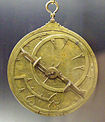 | Crippled by a paralytic disease from early childhood, he was a Benedictine monk who composed famous Marian antiphons and was beatified. As a scientist, he wrote on topics such as geometry, mathematics, and the astrolabe (pictured).[13] |
| Hugh of Saint Victor (c.1096–1141) |  | Influential mystic and philosopher who embraced science as a tool for approaching God. He was master of the monastic school of Saint Victor. His work presents knowledge of reality as redemptive of fallen man; and technology as source of physical relief and able to help reunite man with divine wisdom. "Learn everything," he urged; "later you will see that nothing is superfluous."[14][15] |
| William of Conches (c.1090–a.1154) |  | Scholastic philosopher who sought to expand Christian humanism by studying secular works of the classics and fostering empirical science. He held an atomistic explanation of nature, and his hexameron is a notable example of the naturalism that came to characterize later medieval accounts of the six days of creation. He was a leading member of the cathedral school at Chartres.[16][14] |
| Hildegard of Bingen (1098–1179) |  | Benedictine abbess, writer, composer, philosopher, mystic, visionary, polymath and Germany's first female physician. She conducted and published comprehensive studies of natural science and medicine. Hildegard was well known in her own century as "the female prophet" and is venerated as a Catholic saint.[17] |
1201–1400 (13th and 14th centuries)
The translation of scientific texts continued. By 1200, there were reasonably accurate Latin versions of the main classical works. Meanwhile, the new universities were rapidly spreading through Europe and providing a new infrastructure for scientific communities. They became the main institutions in which the new texts were studied and elaborated. In fact, the medieval university curriculum laid much more emphasis on scientific knowledge than does its modern descendent.[18] This all lead to innovative scientific work being done, especially in the 14th century.
| Name | Image | Reason for inclusion |
|---|---|---|
| Robert Grosseteste (c.1175–1253) |  | Bishop of Lincoln, he was the central character of the English intellectual movement in the first half of the 13th century and is considered the founder of scientific thought in Oxford. He had a great interest in the natural world and wrote texts on the mathematical sciences of optics, astronomy and geometry. He affirmed that experiments should be used in order to verify a theory, testing its consequences.[19] |
| Pope John XXI (c.1215–1277) |  | He wrote the widely used medical text Thesaurus pauperum before becoming Pope. When he took office as pope in 1277, he immediately cracked down on heterodoxy including Averroes works and teachings on Aristotle.[20] |
| Albertus Magnus (c.1193–1280) |  | Patron saint of scientists in Catholicism who may have been the first to isolate arsenic. He wrote that: "Natural science does not consist in ratifying what others have said, but in seeking the causes of phenomena." Yet he rejected elements of Aristotelianism that conflicted with Catholicism and drew on his faith as well as Neo-Platonic ideas to "balance" "troubling" Aristotelian elements.[note 2][21] |
| Roger Bacon (c.1214–1294) |  | He was an English philosopher who emphasized empiricism and has been presented as one of the earliest advocates of the modern scientific method. He joined the Franciscan Order around 1240, where he was influenced by Grosseteste. Bacon was responsible for making the concept of "laws of nature" widespread, and contributed in such areas as mechanics, geography and, most of all, optics.[22] |
| Theodoric of Freiberg (c.1250–c.1310) | 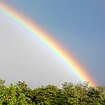 | Dominican who is believed to have given the first correct explanation for the rainbow in De iride et radialibus impressionibus or On the Rainbow. In theology he disagreed with Thomas Aquinas on metaphysical positions and tended towards a more Neoplatonic outlook than Aquinas.[23] |
| Thomas Bradwardine (c.1290–1349) | 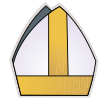 | He was an English archbishop, often called "the Profound Doctor". He developed studies as one of the Oxford Calculators of Merton College, Oxford University. These studies would lead to important developments in mechanics.[24] |
| William of Ockham (c.1285–c.1350) |  | He was an EnglishFranciscanfriar and scholasticphilosopher. He is a major figure of medieval thought and was at the center of the major intellectual and political controversies of his time. Commonly known for Occam's razor, the scientific/methodological principle that bears his name, he also produced significant works on logic, physics, and theology.[25] |
| Jean Buridan (c.1300–c.1358) |  | He was a Catholic priest and one of the most influential philosophers of the later Middle Ages. He developed the theory of impetus, which was an important step toward the modern concept of inertia.[26] |
| Nicephorus Gregoras (c.1295-1360) |  | He was a figure in the Hesychast controversy and took a position against Palamism. In science he proposed a calendar revision, wrote on the astrolabe, and was part of a revival in Byzantine astronomy. He was from Heraclea Pontica, hence the map for a picture.[27][28] |
| Nicole Oresme (c.1323–1382) |  | Theologian and bishop of Lisieux, he was one of the early founders and popularizers of modern sciences. One of his many scientific contributions is the discovery of the curvature of light through atmospheric refraction.[29] |
1401–1600 (15th and 16th centuries)
Around 1350, the Black Death and other disasters sealed a sudden end to the previous period of massive philosophic and scientific development. Even during the initial portion of the Renaissance, the amount of scientific activity remained depressed.[30]
Yet, developments such as the printing press and the dissemination of algebra would soon have important consequences. From around 1475 scientific inquiry resumed and later reached levels previously unseen. It was a period of great upheaval: the Fall of Constantinople; the discovery of the Americas; the Protestant Reformation and the CatholicCounter-Reformation presaged large social and political changes. Indeed, the publication of Copernicus' heliocentric model of the cosmos (1543) is seen by many as marking the beginning of a scientific revolution.
| Name | Image | Reason for inclusion |
|---|---|---|
| Nicholas of Cusa (1401–1464) |  | Catholic cardinal and theologian who made contributions to the field of mathematics by developing the concepts of the infinitesimal and of relative motion. His philosophical speculations also anticipated Copernicus’ heliocentric world-view.[31] |
| Otto Brunfels (1488–1534) | 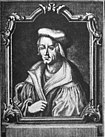 | A theologian and botanist from Mainz, Germany. His Catalogi virorum illustrium is considered to be the first book on the history of evangelical sects that had broken away from the Catholic Church. In botany his Herbarum vivae icones helped earn him acclaim as one of the "fathers of botany".[32] |
| Nicolaus Copernicus (1473–1543) |  | Catholic canon who introduced a heliocentric world view. In 1616, in connection with the Galileo affair, this work was forbidden by the Church "until corrected". Nine sentences representing heliocentricism as certain had to be either omitted or changed. This done, the reading of the book was allowed.[33] Only in 1835 the original uncensored version was dropped from the Index of Prohibited Books.[34] |
| Michael Servetus (1511–1553) | 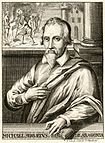 | Nontrinitarian who was condemned and imprisoned by Catholics before being burned at the stake by Calvinists in Protestant-run Geneva. In science wrote on astronomy and his theological work "Christianismi Restitutio" contained the first European description of the function of pulmonary circulation.[35] |
| Michael Stifel (c.1486–1567) |  | Augustinian monk and mathematician who became an early supporter of Martin Luther. His Arithmetica integra (pictured) contained important innovations in mathematical notation and a table of integers and powers of 2 that some have considered to be an early version of a logarithmic table.[36][37] He also wrote on Biblical prophecies.[38] |
| William Turner (c.1508–1568) |  | He is sometimes called the "father of English botany" and was also an ornithologist. Religiously he was arrested for preaching in favor of the Reformation. He later became a Dean of Wells Cathedral, pictured, but was expelled for nonconformity.[39] |
| Ignazio Danti (1536–1586) |  | As bishop of Alatri he convoked a diocesan synod to deal with abuses. He was also a mathematician who wrote on Euclid, an astronomer, and a designer of mechanical devices.[40] |
| Giordano Bruno (1548–1600) |  | Italian philosopher, priest, cosmologist, and occultist, known for espousing the idea the that Earth revolves around the Sun and that many other worlds revolve around other suns. For his many heretical views, including his denial of the divinity of Christ, he was tried by the Roman Inquisition and burned at the stake. The Catholic Encyclopedia labels his system of beliefs "an incoherent materialistic pantheism."[41] |
1601–1700 (17th century)
If the scientific revolution started in the 16th century, it was now in full operation. New ideas in physics, astronomy, biology, human anatomy, chemistry, and other sciences were posing a challenge for many conceptions about nature that had prevailed starting in Ancient Greece and continuing through the Middle Ages. This eventually led to the rejection of the old views and established a new framework for the study of nature. The period culminated with the publication of the Philosophiæ Naturalis Principia Mathematica in 1687 by Isaac Newton, representative of the unprecedented growth of scientific publications throughout Europe. Newton is presented in the next section of the list, since he died in 1720.
| Name | Image | Reason for inclusion |
|---|---|---|
| Bartholomaeus Pitiscus (1561–1613) |  | He may have introduced the word trigonometry into English and French. He was also a Calvinist theologian who acted as court preacher at the town then called Breslau, hence the image of their town square.[42] |
| John Napier (1550–1617) |  | Scottish mathematician known for inventing logarithms, Napier's bones, and being the popularizer of the use of decimals. He also was a staunch Protestant who wrote on the Book of Revelation.[43] |
| Johannes Kepler (1571–1630) |  | His model of the cosmos based on nesting Platonic solids was explicitly driven by religious ideas; his later and most famous scientific contribution, the Kepler's laws of planetary motion, was based on empirical data that he obtained from Tycho Brahe's meticulous astronomical observations, after Tycho died in 1601. He had wanted to be a theologian at one time and his Harmonice Mundi discusses Christ at points.[44] |
| Galileo Galilei (1564–1642) |  | Scientist who had many problems with the Inquisition for defending heliocentrism in the convoluted period brought about by the Reformation and Counter-Reformation. In regard to Scripture, he took Augustine's position: not to take every passage too literally, particularly when the scripture in question is a book of poetry and songs, not a book of instructions or history.[45] |
| Laurentius Gothus (1565–1646) |  | A professor of astronomy and Archbishop of Uppsala. He wrote on astronomy and theology.[46] |
| Marin Mersenne (1588–1648) |  | For four years he devoted himself to theology writing Quaestiones celeberrimae in Genesim (1623) and L'Impieté des déistes (1624). These were theological essays against atheism and deism. He is more remembered for the work he did corresponding with mathematicians and concerning Mersenne primes.[47] |
| René Descartes (1596–1650) |  | He was a key thinker of the Scientific Revolution. He did important work on geometry and is honoured by having the Cartesian coordinate system used in plane geometry and algebra named after him. His Meditations on First Philosophy partially concerns theology and he was devoted to reconciling his ideas with the dogmas of Catholic Faith to which he was loyal.[note 3][48] |
| Pierre Gassendi (1592–1655) |  | Catholic priest who tried to reconcile Atomism with Christianity. He also published the first work on the Transit of Mercury and corrected the geographical coordinates of the Mediterranean Sea.[49] |
| Anton Maria of Rheita (1597–1660) |  | Capuchin astronomer. He dedicated one of his astronomy books to Jesus Christ, a "theo-astronomy" work was dedicated to the Blessed Virgin Mary, and he wondered if beings on other planets were "cursed by original sin like humans are."[50] |
| Blaise Pascal (1623–1662) |  | Jansenist thinker;[note 4] well known for Pascal's law (physics), Pascal's theorem (math), and Pascal's Wager (theology).[51] |
| Isaac Barrow (1630–1677) |  | English divine, scientist, and mathematician. He wrote Expositions of the Creed, The Lord's Prayer, Decalogue, and Sacraments and Lectiones Opticae et Geometricae.[52] |
| Juan Lobkowitz (1606–1682) | 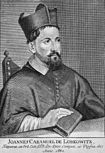 | Cistercian monk who did work on Combinatorics and published astronomy tables at age 10. He also did works of theology and sermons.[53] |
| Nicolas Steno (1638–1686) |  | Lutheran convert to Catholicism, his beatification in that faith occurred in 1987. As a scientist he is considered a pioneer in both anatomy and geology, but largely abandoned science after his religious conversion.[54] |
| Seth Ward (1617–1689) |  | Anglican Bishop of Salisbury and Savilian Chair of Astronomy from 1649–1661. He wrote Ismaelis Bullialdi astro-nomiae philolaicae fundamenta inquisitio brevis and Astronomia geometrica. He also had a theological/philosophical dispute with Thomas Hobbes and as a bishop was severe toward nonconformists.[55] |
| Robert Boyle (1627–1691) | 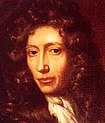 | Scientist and theologian who argued that the study of science could improve glorification of God.[56] |
1701–1800 (18th century)
The 18th century is considered the zenith of the Enlightenment. It was not a single movement or school of thought, it was less a set of ideas than it was a set of values. At its core was a critical questioning of traditional institutions, customs, and morals, and a strong belief in rationality and science. The end of the century saw the French Revolution which led to the first major de-Christianization attempts in Europe to occur in many centuries. This culminated in the Cult of the Supreme Being. The period thus saw Christianity in transition and eventually conflict.
| Name | Image | Reason for inclusion |
|---|---|---|
| John Wallis (1616–1703) |  | As a mathematician he wrote Arithmetica Infinitorumis, introduced the term Continued fraction, worked on cryptography, helped develop calculus, and is further known for the Wallis product. He also devised a system for teaching the non-speaking deaf. He was also a Calvinist inclined chaplain who was active in theological debate.[57] |
| John Ray (1627–1705) |  | English botanist who wrote The Wisdom of God manifested in the Works of the Creation. (1691) The John Ray Initiative of Environment and Christianity is also named for him.[58] |
| Gottfried Leibniz (1646–1716) |  | Polymath who worked on determinants, a calculating machine, He was a Lutheran who worked with convert to Catholicism John Frederick, Duke of Brunswick-Lüneburg in hopes of a reunification between Catholicism and Lutheranism. He also wrote Vindication of the Justice of God.[59] |
| Isaac Newton (1643–1727) |  | He is regarded as one of the greatest scientists and mathematicians in history. Newton's study of the Bible and of the early Church Fathers were among his greatest passions, though he consistently refused to swear his allegiance to the church. He wrote Observations upon the Prophecies of Daniel and the Apocalypse of St. John (Nontrinitarianism).[60]Isaac Newton's religious views are considered by some to be close to deism and several biographers and scholars labeled him as a deist who is strongly influenced by Christianity.[61][62][63][64] However, he differed from strict adherents of deism in that he invoked God as a special physical cause to keep the planets in orbits.[65] |
| Colin Maclaurin (1698–1746) | 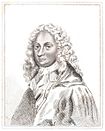 | Proposed to explain Newton'sdifferential calculus using infinite series instead of Newton's fluxions. A Divinity student, he had a Christian institute named for him.[66] |
| Stephen Hales (1677–1761) |  | A Copley Medal winning scientist significant to the study of plant physiology. As an inventor designed a type of ventilation system, a means to distill sea-water, ways to preserve meat, etc. In religion he was an Anglican curate who worked with the Society for the Promotion of Christian Knowledge and for a group working to convert black slaves in the West Indies.[67] |
| Thomas Bayes (1701–1761) | 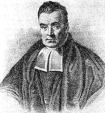 | Presbyterian minister who wrote Divine Benevolence, or an Attempt to Prove That the Principal End of the Divine Providence and Government is the Happiness of His Creatures. He is better known for Bayes' theorem and was made a Fellow of the Royal Society in 1742. [68] |
| Firmin Abauzit (1679–1767) |  | A physicist and theologian. He translated the New Testament into French and corrected an error in Newton's Principia.[69] |
| Emanuel Swedenborg (1688–1772) |  | His writing is the basis of Swedenborgianism and several of his theological works contained some science hypotheses, most notably the Nebular hypothesis for the origin of the Solar System.[70] |
| Carolus Linnaeus (1707–1778) |  | He is known as the "father of modern taxonomy" and also made contributions to ecology. Natural theology and the Bible were important to his Systema Naturae and Systema Vegetabilium.'[71] |
| Leonhard Euler (1707–1783) |  | A significant mathematician and physicist, see List of topics named after Leonhard Euler. He wrote Defense of the Divine Revelation against the Objections of the Freethinkers and is also commemorated by the Lutheran Church on their Calendar of Saints on May 24.[72] |
| Maria Gaetana Agnesi (1718–1799) |  | Mathematician appointed to a position by Pope Benedict XIV. After her father died she devoted her life to religious studies, charity, and ultimately became a nun.[73] |
1801–1900 (19th century)
This period led Christians in science to face changes and increased challenges. It was the 19th century that brought the professionalization of the scientific enterprise. By then, religious thinkers who expressed themselves on scientific subjects were increasingly treated as "trespassers". This was also the first century that saw actual discussions of the "relationship between science and religion". In previous ages there was occasional concern about tension between faith and reason, but religion and science were not presented as two opposing forces. This ethos gave birth to the conflict thesis. At the end of the century it was common the view that science and religion "had been in a state of constant conflict". This notion is still very popular, although it is not endorsed by current research on the history of science.[74]
| Name | Image | Reason for inclusion |
|---|---|---|
| Joseph Priestley (1733–1804) |  | Nontrinitarianism clergyman who wrote the controversial work History of the Corruptions of Christianity. He is credited with discovering oxygen.[note 5] |
| Isaac Milner (1750–1820) | 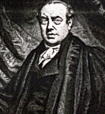 | Lucasian Professor of Mathematics known for work on an important process to fabricate Nitrous acid. He was also an evangelical Anglican who co-wrote Ecclesiastical History of the Church of Christ with his brother and played a role in the religious awakening of William Wilberforce. He also led to William Frend being expelled from Cambridge for a purported attack by Frend on religion.[75] |
| Samuel Vince (1749–1821) |  | Cambridge astronomer and clergyman. He wrote Observations on the Theory of the Motion and Resistance of Fluids and The credibility of Christianity vindicated, in answer to Mr. Hume’s objections. He won the Copley Medal in 1780, before the period dealt with here ended.[76] |
| Olinthus Gregory (1774–1841) |  | He wrote Lessons Astronomical and Philosophical in 1793 and became mathematical master at the Royal Military Academy in 1802. An abridgment of his 1815 Letters on the Evidences of Christianity was done by the Religious Tract Society.[77] |
| Bernard Bolzano (1781–1848) | 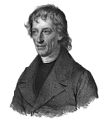 | Mathematician and Roman Catholic priest, credited with being the first to propose what became known as the Bolzano–Weierstrass theorem. He was also the first to provide a purely analytical proof of the Intermediate value theorem.[78] |
| William Buckland (1784–1856) |  | Anglican priest/geologist who wrote Vindiciae Geologiae; or the Connexion of Geology with Religion explained. He was born in 1784, but his scientific life did not begin before the period discussed herein.[79] |
| Augustin-Louis Cauchy (1789–1857) |  | Mathematician who defended the Society of Jesus, tried to convert other mathematicians to Catholicism, and was a member of the Society of Saint Vincent de Paul.[80] |
| Lars Levi Læstadius (1800–1861) |  | Botanist who started a revival movement within Lutheranism called Laestadianism. This movement is among the strictest forms of Lutheranism. As a botanist he has the author citation Laest and discovered four species.[81] |
| George Boole (1815–1864) | 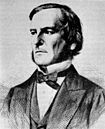 | English mathematician and logician who authored The Laws of Thought. His theology was heavily influenced by Unitarianism, although he did not formally belong to a Unitarian church.[82] |
| Edward Hitchcock (1793–1864) |  | Geologist, paleontologist, and Congregationalist pastor. He worked on Natural theology and wrote on fossilized tracks.[83] |
| William Whewell (1794–1866) |  | A professor of mineralogy and moral philosophy. He wrote An Elementary Treatise on Mechanics in 1819 and Astronomy and General Physics considered with reference to Natural Theology in 1833.[84] |
| Michael Faraday (1791–1867) | 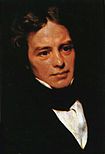 | A Glasite church elder for a time, he discussed the relationship of science to religion in a lecture opposing Spiritualism.[85] |
| Charles Babbage (1791–1871) |  | The Difference Engine and the Ninth Bridgewater Treatise.[86] |
| Adam Sedgwick (1785–1873) |  | Anglican priest and geologist whose, A Discourse on the Studies of the University discusses the relationship of God and man. In science he won both the Copley Medal and the Wollaston Medal.[87] |
| Temple Chevallier (1794–1873) | 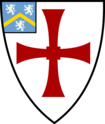 | Priest and astronomer who did Of the proofs of the divine power and wisdom derived from the study of astronomy. He also founded the Durham University Observatory, hence the Durham Shield is pictured.[88] |
| John Bachman (1790–1874) |  | Wrote numerous scientific articles and named several species of animals. He also was a founder of the Lutheran Theological Southern Seminary and wrote works on Lutheranism.[89] |
| Robert Main (1808–1878) |  | Anglican priest who won the Gold Medal of the Royal Astronomical Society in 1858. (The image is of Asaph Hall's 1879 Gold Medal of the RAS.) Robert Main also preached at the British Association of Bristol.[90] |
| James Clerk Maxwell (1831–1879) | 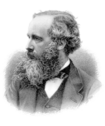 | Although Clerk as a boy was taken to Presbyterian services by his father and to Anglican services by his aunt, while still a young student at Cambridge he underwent an Evangelical conversion that he described as having given him a new perception of the Love of God.[note 6] Maxwell's evangelicalism "committed him to an anti-positivist position."[91][92] |
| Andrew Pritchard (1804–1882) |  | English naturalist and experimental physicist. He became a leading member of north London's Newington Green Unitarian Church (pictured).[93] |
| Arnold Henry Guyot (1807–1884) |  | Swiss-American geologist who did noteworthy work on glaciers, Guyot Glacier is named for him. He also wrote Creation, or the Biblical Cosmogony in the Light of Modern Science.[94] |
| Gregor Mendel (1822–1884) |  | AugustinianAbbot who was the "father of modern genetics" for his study of the inheritance of traits in pea plants.[95] |
| Philip Henry Gosse (1810–1888) |  | Marine biologist who wrote Aquarium (1854), and A Manual of Marine Zoology (1855–56). He is more famous, or infamous, as a Christian Fundamentalist who coined the idea of Omphalos (theology).[96] |
| Asa Gray (1810–1888) |  | His Gray's Manual remains a pivotal work in botany. His Darwiniana has sections titled "Natural selection not inconsistent with Natural theology", "Evolution and theology", and "Evolutionary teleology." The preface indicates his adherence to the Nicene Creed in concerning these religious issues.[97] |
| Francesco Faà di Bruno (1825—1888) | 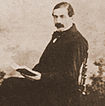 | Italian mathematician most linked to Turin. He is known for Faà di Bruno's formula and being a spiritual writer beatified in 1988.[98] |
| Julian Tenison Woods (1832–1889) | Co-founder of the Sisters of St Joseph of the Sacred Heart who won a Clarke Medal shortly before death. A picture from Waverley Cemetery, where he's buried, is shown.[99] | |
| James Prescott Joule (1818–1889) |  | He established that the various forms of energy such as mechanical, electrical, and heat were all basically the same and can be converted to one another. This helped develop the first law of thermodynamics and correspondingly the law of conservation of energy. The unit of energy, Joule, was named after him.[100] |
| Heinrich Hertz (1857-1894) |  | A German physicist known for electromagnetic radiation and photoelectric effect. The scientific unit of frequency, hertz, is named in his honor. He was a Lutheran all his life.[101] |
| James Dwight Dana (1813–1895) |  | A geologist, mineralogist, and zoologist. He received the Copley Medal, Wollaston Medal, and the Clarke Medal. He also wrote a book titled Science and the Bible and his faith has been described as "both orthodox and intense."[102] |
| Louis Pasteur (1822–1895) |  | Inventor of the pasteurization method, a French chemist and microbiologist. He also solved the mysteries of rabies, anthrax, chicken cholera, and silkworm diseases, and contributed to the development of the first vaccines.[103] |
| George Jackson Mivart (1827–1900) |  | Fellow of the Zoological Society of London who did notable work on Insectivora and became involved in controversies with Charles Darwin. He was also a convert to Catholicism who taught at the Catholic University of Leuven and received a Doctor of Philosophy from Pope Pius IX in 1876, However his later works were considered unorthodox and led to his excommunication by Cardinal Vaughan.[104] |
| Armand David (1826–1900) | 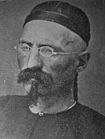 | Catholic missionary to China and member of the Lazarists who considered his religious duties to be his principal concern. He was also a botanist with the author abbreviation David and as a zoologist he described several species new to the West.[105] |
1901–2000 (20th century)
During the previous century, the practice of science became professionalized and institutionalized in ways that continued through the 20th century. As the role of scientific knowledge grew in society, it became incorporated with many aspects of the functioning of nation-states.
| Name | Image | Reason for inclusion |
|---|---|---|
| George Stokes (1819–1903) |  | A minister's son, he wrote a book on Natural Theology. He was also one of the Presidents of the Royal Society and made contributions to Fluid dynamics.[106] |
| George Salmon (1819–1904) |  | He won the Copley Medal for his mathematical works. In theology his book An Historical Introduction to the Study of the Books of the New Testament was widely read and he wrote rebuttals to John Henry Newman tracts.[107] |
| Henry Baker Tristram (1822–1906) | A founding member of the British Ornithologists' Union. His publications included The Natural History of the Bible (1867) and The Fauna and Flora of Palestine (1884).[108] | |
| Lord Kelvin (1824–1907) |  | He gave a famous address to the Christian Evidence Society. In science he won the Copley Medal, the Royal Medal, and was important in Thermodynamics.[109] |
| Pierre Duhem (1861–1916) |  | He worked on Thermodynamic potentials and wrote histories advocating that the Roman Catholic Church helped advance science.[110] |
| Georg Cantor (1845–1918) |  | Lutheran who wrote on religious topics and had an interest in Medieval theology. Revolutionized the mathematical notion of infinity by the introduction of set theory.[111] |
| Henrietta Swan Leavitt (1868–1921) |  | A minister's daughter and noted astronomer who was the head of Photometry (astronomy) at Harvard. A practicing Congregationalist, Leavitt was the descendant of early Massachusetts Bay ColonyPuritansettlers.[112] |
| Charles Doolittle Walcott (1850-1927) |  | Walcott was a paleontologist, most notable for his discovery of the Burgess Shell of British Columbia. The late Stephen Jay Gould said that Walcott, "discoverer of the Burgess Shale fossils, was a convinced Darwinian and an equally firm Christian, who believed that God had ordained natural selection to construct a history of life according to His plans and purposes."[113] |
| Dmitri Egorov (1869–1931) |  | Russian mathematician who made significant contributions to the broader areas of differential geometry. He was an Imiaslavie who defended religion during the Soviet era. In 1930 the Soviets arrested and imprisoned him as a "religious sectarian." He died of a hunger strike in protest.[114] |
| Mihajlo Pupin (1858–1935) |  | Serbian-American physicist, chemist, and inventor. He won the Pulitzer Prize for Biography or Autobiography in 1924. His The New Reformation: From Physical to Spiritual Realities concerns religion and spirituality. He also wrote the forward to Science & Religion: A Symposium.[115] |
| Pavel Florensky (1882–1937) |  | Russian Orthodox priest who wrote a book on Dielectrics and wrote of imaginary numbers having a relationship to the Kingdom of God.[116] |
| Agnes Giberne (1845–1939) |  | She wrote for the Religious Tract Society and was a founding member of the British Astronomical Association. The picture comes from her book Sun, Moon and Stars, which references the Bible while discussing science.[117] |
| J. J. Thomson (1856-1940) |  | J.J. Thompson, or Sir Joseph John "J. J." Thomson, was a British physicist who discovered electrons and isotopes. He won the Nobel Prize for Physics in 1906 and was President of the Royal Society from 1915 to 1920. Thompson is described as "a regular communicant in the Anglican Church. In addition, he showed an active interest in the Trinity Mission at Camberwell. With respect to his private devotional life, J. J. would invariably practice kneeling for daily prayer, and read his Bible before retiring each night."[118] |
| George Washington Carver (1864-1943) |  | George Washington Carver was an American scientist, botanist, educator, and inventor. Carver believed he could have faith both in God and science and integrated them into his life. He testified on many occasions that his faith in Jesus was the only mechanism by which he could effectively pursue and perform the art of science.[119] |
| Arthur Eddington (1882-1944) |  | Sir Arthur Stanley Eddington was a British astrophysicist of the early 20th century. He was also a philosopher of science and a popularizer of science. The Eddington limit, the natural limit to the luminosity of stars, or the radiation generated by accretion onto a compact object, is named in his honor. He is famous for his work regarding the theory of relativity. Eddington was a lifelong Quaker, and gave the Gifford Lectures in 1927. [120] |
| John Ambrose Fleming (1849–1945) |  | In science he is noted for the Right-hand rule and work on vacuum tubes. He also won the Hughes Medal. In religious activities he was President of the Victoria Institute, and preached at St Martin-in-the-Fields.[121] |
| Max Planck (1858–1947) |  | He won the 1918 Nobel Prize in Physics and is considered the founder of Quantum mechanics. He had been raised an observant Lutheran and was an elder in his church from 1920 to his death. In 1937 he delivered the lecture, "Religion and Natural Science", stating that both religion and science require a belief in God.[note 7][122] |
| Edward Arthur Milne (1896–1950) |  | British astrophysicist and mathematicians who proposed the Milne model and had a Moon crater named for him. In addition he won several awards one of which, the Gold Medal of the Royal Astronomical Society, is pictured. His last book was Modern Cosmology and the Christian Idea of God.[123] |
| Robert Millikan (1868–1953) |  | The second son of Reverend Silas Franklin Millikan, he wrote about the reconciliation of science and religion in books like Evolution in Science and Religion. He won the 1923 Nobel Prize in Physics.[124] |
| Charles Stine (1882–1954) | The son of a minister who was VP of DuPont. In religion he wrote A Chemist and His Bible and as a chemist he won the Perkin Medal.[125] | |
| E. T. Whittaker (1873–1956) |  | Converted to Catholicism in 1930 and member of the Pontifical Academy of Sciences. His 1946 Donnellan Lecture was entitled on Space and Spirit. Theories of the Universe and the Arguments for the Existence of God. He also received the Copley Medal and had written on Mathematical physics before conversion.[126] |
| Arthur Compton (1892–1962) |  | He won a Nobel Prize in Physics. He also was a deacon in the Baptist Church and wrote an article in Christianity Takes a Stand that supported the controversial idea of the United States maintaining the peace through a nuclear-armed air force.[127] |
| Ronald Fisher (1890–1962) |  | English statistician, evolutionary biologist and geneticist. He preached sermons and published articles in church magazines.[128] |
| Georges Lemaître (1894–1966) |  | Roman Catholic priest who was first to propose the Big Bang theory.[129] |
| Otto Hahn (1879–1968) |  | Cherman chemist and Luterhan who won the 1944 Nobel Prize in Chemistry.[130] |
| David Lack (1910–1973) |  | Director of the Edward Grey Institute of Field Ornithology and convert who wrote Evolutionary Theory and Christian Belief in 1957. As he is in part known for his study of the genus Euplectes a Black-winged Red Bishop is pictured.[131] |
| Charles Coulson (1910–1974) |  | Methodist who wrote Science and Christian Belief in 1955. In 1970 he won the Davy Medal.[132] |
| George R. Price (1922-1975) |  | An American population geneticist who while a strong atheist converted to Christianity. He went on to write commentaries on the New Testament and dedicated portions of his life to helping the poor.[133] |
| Theodosius Dobzhansky (1900–1975) |  | Russian Orthodox geneticist who criticized young Earth creationism in an essay, "Nothing in Biology Makes Sense Except in the Light of Evolution," and argued that science and faith did not conflict.[134][135] |
| Werner Heisenberg (1901–1976) | 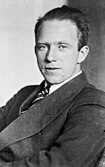 | German theoretical physicist who made significant contributions to quantum mechanics, nuclear physics and quantum field theory. He was a practising Lutheran.[136][137] |
| Michael Polanyi (1891–1976) |  | He was born Jewish, but became a Christian. In 1926 he was appointed to a Chemistry chair in Berlin, but in 1933 when Hitler came to power he accepted a Chemistry chair (and then in 1948 a Social Sciences chair) at the University of Manchester. In 1946 he wrote Science, Faith, and Society ISBN 0-226-67290-5.[138] |
| Kurt Gödel (1906-1978) |  | An Austrian mathematician, logician, and philosopher, Godel is known for what are called Gödel's incompleteness theorems, Gödel's completeness theorem, among other things. Godel was baptized Lutheran, and remained a believer in God his whole life.[139] He believed firmly in an afterlife, stating: "Of course this supposes that there are many relationships which today's science and received wisdom haven't any inkling of. But I am convinced of this [the afterlife], independently of any theology." It is "possible today to perceive, by pure reasoning" that it "is entirely consistent with known facts." "If the world is rationally constructed and has meaning, then there must be such a thing [as an afterlife]."[140] He also developed Gödel's ontological proof for the existence of God, which was published after his death. |
| Henry Eyring (1901–1981) |  | American chemist known for developing the Eyring equation. Also a Latter-Day Saint whose interactions with LDS President Joseph Fielding Smith on science and faith are a part of LDS history.[141] |
| Sewall Wright (1889–1988) |  | American geneticist known for his influential work on evolutionary theory and also for his work on path analysis. He was a practising Unitarian.[142] |
| William G. Pollard (1911–1989) |  | Anglican priest who wrote Physicist and Christian. In addition he worked on the Manhattan Project and for years served as the executive director of Oak Ridge Institute of Nuclear Studies.[143] |
| Frederick Rossini (1899- 1990) |  | An American noted for his work in chemical thermodynamics. In science he received the Priestley Medal and the National Medal of Science. An example of the second medal is pictured. As a Catholic he received the Laetare Medal of the University of Notre Dame. He was dean of the College of Science at Notre Dame from 1960 to 1971, a position he may have taken partly due to his faith.[144][145] |
| Aldert van der Ziel (1910–1991) |  | He researched Flicker noise and has the Institute of Electrical and Electronics Engineers named an award for him. The IEEE corporate office is pictured. He also was a conservative Lutheran who wrote The Natural Sciences and the Christian Message.[146] |
| Mary Celine Fasenmyer (1906-1996) |  | Member of the Sisters of Mercy known for Sister Celine's polynomials. Her work was also important to WZ Theory.[147] A picture of a site in Erie, Pennsylvania is displayed as she lived there. |
| John Eccles (1903-1997) |  | A Nobel laureate and neurophysiologist who was a devout theist and a practicing Catholic.[148] |
| Carlos Chagas Filho (1910–2000) |  | Neuroscientist who headed the Pontifical Academy of Sciences for 16 years. He studied the Shroud of Turin and his "the Origin of the Universe", "the Origin of Life", and "the Origin of Man" involved an understanding between Catholicism and Science. He was from Rio de Janeiro, hence the well known Christ the Redeemer statue is pictured.[149] |
2001–today (21st century)
Interest in the relationship between science and religion has increased in recent decades due to continued controversies and recognition from awards like the Templeton Prize.
| Name | Image | Reason for inclusion |
|---|---|---|
| Sir Robert Boyd (1922–2004) | A pioneer in British space science who was Vice President of the Royal Astronomical Society. He lectured on faith being a founder of the "Research Scientists' Christian Fellowship" and an important member of its predecessor Christians in Science. He was connected to the University College London which is shown here in an old drawing.[150] | |
| Richard Smalley (1943–2005) |  | A Nobel Laureate in Chemistry known for buckyballs. In his last years he renewed an interest in Christianity and supported Intelligent design.[151] |
| Mariano Artigas (1938–2006) |  | He had doctorates in both physics and philosophy. He belonged to the European Association for the Study of Science and Theology and also received a Templeton Foundation prize for his work in the area of science and religion.[152] The picture is from the University of Navarra where he taught. |
| Arthur Peacocke (1924–2006) |  | Anglican priest and biochemist, his ideas may have influenced Anglican and Lutheran views of evolution. Winner of the 2001 Templeton Prize. He was a Dean at Clare College, Cambridge, which is pictured.[153] |
| C. F. von Weizsäcker (1912–2007) |  | German nuclear physicist who is the co-discoverer of the Bethe-Weizsäcker formula. His The Relevance of Science: Creation and Cosmogony concerned Christian and moral impacts of science. He headed the Max Planck Society from 1970 to 1980. After that he retired to be a Christian pacifist.[154] |
| Stanley Jaki (1924–2009) |  | Benedictine priest and Distinguished Professor of Physics at Seton Hall University, New Jersey, who won a Templeton Prize and advocated the idea modern science could only have arisen in a Christian society.[155] |
| Allan Sandage (1926–2010) |  | An astronomer who did not really study Christianity until after age forty. He wrote the article A Scientist Reflects on Religious Belief and made discoveries concerning the Cigar Galaxy which is pictured.[156] |
| Joseph Murray (1919-2012) | A Catholic surgeon who pioneered transplant surgery. He won the Nobel Prize in Physiology or Medicine in 1990.[157] |
Living
This section concerns significant Christian thinkers in science who are alive today. Those who lead organizations of Christians in science or who write works concerning how Christians of today respond to science.
| Name | Image | Reason for inclusion |
|---|---|---|
| Charles Hard Townes (born 1915) |  | In 1964 he won the Nobel Prize in Physics and in 1966 he wrote The Convergence of Science and Religion. The picture is of Townes with Dr. Roderic Pettigrew, Townes is on the right.[158] |
| Ian Barbour (born 1923) | Physicist who wrote Christianity and the Scientists in 1960, and When Science Meets Religion ISBN 0-06-060381-X in 2000. For years he taught at Carleton College, hence their observatory is pictured.[159] | |
| Freeman Dyson (born 1923) | 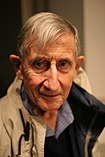 | He has won the Lorentz Medal, the Max Planck Medal, and the Lewis Thomas Prize. He also ranked 25th in The 2005 Global Intellectuals Poll. He has won the Templeton Prize and delivered one of the Gifford Lectures |
| Richard H. Bube (born 1927) | He is an emeritus professor of the material sciences at Stanford University. He is a member of the American Scientific Affiliation.[160] | |
| Werner Arber (born 1929) |  | Werner Arber is a Swiss microbiologist and geneticist. Along with American researchers Hamilton Smith and Daniel Nathans, Werner Arber shared the 1978 Nobel Prize in Physiology or Medicine for the discovery of restriction endonucleases. In 2011, Pope Benedict XVI appointed Arber as President of the Pontifical Academy—the first Protestant to hold that position.[161] |
| Antonino Zichichi (born 1929) |  | Italian nuclear physicist and former President of the Istituto Nazionale di Fisica Nucleare. He has worked with the Vatican on relations between the Church and Science.[162] |
| John Polkinghorne (born 1930) |  | British particle physicist and Anglican priest who wrote Science and the Trinity (2004) ISBN 0-300-10445-6. Winner of the 2002 Templeton Prize.[163] |
| Owen Gingerich (born 1930) | Mennonite astronomer who went to Goshen College and Harvard. An old picture of Goshen is shown. Mr. Gingerich has written about people of faith in science history.[164] | |
| John T. Houghton (born 1931) | He is the co-chair of the Intergovernmental Panel on Climate Change and won a gold medal from the Royal Astronomical Society. He's also former Vice President of Christians in Science.[165] | |
| Russell Stannard (born 1931) | British particle physicist who has written several books on the relationship between religion and science, such as Science and the Renewal of Belief, Grounds for Reasonable Belief and Doing Away With God?.[166] | |
| John Gurdon (born 1933) |  | Sir John Bertrand Gurdon is a British developmental biologist. In 2012, he and Shinya Yamanaka were awarded the Nobel Prize for Physiology or Medicine for the discovery that mature cells can be converted to stem cells. He has also recently participated in a Vatican conference on stem-cell research. In an interview with EWTN.com on the subject of working with people of different opinions, he says "I'm what you might call liberal minded. I'm not a Roman Catholic. I'm a Christian, of the Church of England. And I don't agree with some of the rules that the Roman Catholics have. But that's why it's very interesting for me to meet people here to tell me why they have the various rules they do. And I've never seen the Vatican before, so that's a new experience, and I'm grateful for it."[167] |
| R. J. Berry (born 1934) |  | He is a former president of both the Linnean Society of London and the Christians in Science group. He also wrote God and the Biologist: Personal Exploration of Science and Faith (Apollos 1996) ISBN 0-85111-446-6 As he taught at University College London for over 20 years its main building is pictured.[168] |
| Gerhard Ertl (born 1936) |  | He is a 2007 Nobel Prize winner in Chemistry. He has said in an interview that "I believe in god. (...) I am a Christian and I try to live as a Christian (...) I read the bible very often and I try to understand it."[169] |
| Michał Heller (born 1936) |  | He is a Catholic priest, a member of the Pontifical Academy of Theology, a founding member of the International Society for Science and Religion. He also is a mathematical physicist who has written articles on relativistic physics and Noncommutative geometry. His cross-disciplinary book Creative Tension: Essays on Science and Religion came out in 2003. For this work he won a Templeton Prize. [note 8][170] |
| Robert Griffiths (born 1937) | A noted American physicist at Carnegie Mellon University. He has written on matters of science and religion.[171] | |
| Ghillean Prance (born 1937) | Noted botanist involved in the Eden Project, which is pictured. He is also the current President of Christians in Science.[172] | |
| Donald Knuth (born 1938) |  | (Lutheran) The Art of Computer Programming and 3:16 Bible Texts Illuminated (1991), ISBN 0-89579-252-4.[173] |
| George Francis Rayner Ellis (born 1939) | One of the world's leading theorists in cosmology and a winner of the Templeton Prize, Ellis is a Christian and has written on theology and science. He is described as "Ellis provides a Christian setting for the design argument by describing the “essential core” of New Testament teaching based on [William] Temple’s theology and his own Quaker perspective."[174] | |
| Colin Humphreys (born 1941) | He is a British physicist. He is the former Goldsmiths’ Professor of Materials Science and a current Director of Research at Cambridge University, Professor of Experimental Physics at the Royal Institution in London and a Fellow of Selwyn College, Cambridge. Humphreys also "studies the Bible when not pursuing his day-job as a materials scientist."[175] | |
| John Suppe (born 194?) | He is a Professor of Geology at National Taiwan University and Princeton University. He has written articles like "Thoughts on the Epistemology of Christianity in Light of Science."[176] | |
| Jocelyn Bell Burnell (born 1943) |  | Burnell is a Northern Irish astrophysicist. As a postgraduate student, she discovered the first radio pulsars with her thesis supervisor Antony Hewish, for which Hewish shared the Nobel Prize in Physics. Bell Burnell was President of the Royal Astronomical Society from 2002 to 2004, president of the Institute of Physics from October 2008 until October 2010. She is a Quaker, and has described her beliefs thus: "Spirituality forms the center of my life and is the driver. As far as I am concerned everything begins and ends here," she says. "Astrophysics feeds into my spiritual life only in a minor way. The sense of God that comes to me in still times is so profound that nothing else holds a candle to it."[177] |
| Eric Priest (born 1943) |  | An authority on Solar Magnetohydrodynamics who won the George Ellery Hale Prize among others. He has spoken on Christianity and Science at the University of St Andrews and is a member of the Faraday Institute. An image from St. Andrews is shown. He is also interested in prayer, meditation, and Christian psychology.[178] |
| Christopher Isham (born 1944) |  | Theoretical physicist who developed HPO formalism. He teaches at Imperial College London, part of which is pictured to the side. In addition to being a physicist, he is a philosopher and theologian.[179] |
| Henry F. Schaefer, III (born 1944) |  | He wrote Science and Christianity: Conflict or Coherence? ISBN 0-9742975-0-X and is a signatory of A Scientific Dissent From Darwinism. He was awarded the American Chemical Society Award in Pure Chemistry in 1979.[180] |
| Robert T. Bakker (born 1945) |  | Paleontologist who was a figure in the "dinosaur Renaissance" and known for the theory some dinosaurs were Warm-blooded. He is also a Pentecostal preacher who advocates theistic evolution and has written on religion.[181] |
| Joan Roughgarden (born 1946) | An evolutionary biologist who has taught at Stanford University since 1972. She wrote the book Evolution and Christian Faith: Reflections of an Evolutionary Biologist.[182] | |
| Darrel R. Falk (born 1946) |  | Darrel Falk is an American biologist and the former president of the BioLogos Foundation.[183] |
| J. Richard Gott (born 1947) |  | Gott is a professor of astrophysical sciences at Princeton University. He is known for developing and advocating two cosmological theories with the flavor of science fiction: Time travel and the Doomsday argument. When asked of his religious views in relation to his science, Gott responded that "I’m a Presbyterian. I believe in God; I always thought that was the humble position to take. I like what Einstein said: “God is subtle but not malicious.” I think if you want to know how the universe started, that’s a legitimate question for physics. But if you want to know why it’s here, then you may have to know—to borrow Stephen Hawking’s phrase—the mind of God."[184] |
| William B. Hurlbut (born 194?) |  | William Hurlbut is a physician and Consulting Professor at the Stanford Neuroscience Institute, Stanford University Medical Center. In addition to teaching at Stanford, Hurlbut served for eight years on the President's Council on Bioethics and is nationally known for his advocacy of Altered Nuclear Transfer (ANT).[185] |
| William Daniel Phillips (born 1948) | 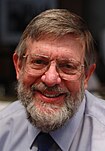 | 1997 Nobel Laureate in Physics (1997) who is a founding member of The International Society for Science and Religion.[186] |
| Kenneth R. Miller (born 1948) |  | Biology professor at Brown University who wrote Finding Darwin's God ISBN 0-06-093049-7.[187] |
| Francis Collins (born 1950) |  | He is the current director of the National Institutes of Health and former director of the US National Human Genome Research Institute. He has also written on religious matters in articles and in Faith and the Human Genome he states the importance to him of "the literal and historical Resurrection of Jesus Christ from the dead, which is the cornerstone of what I believe." He wrote the book The Language of God: A Scientist Presents Evidence for Belief.[188] |
| Noella Marcellino (born 1951) |  | American Benedictine nun with a degree in microbiology. Her field of interests include fungi and the effects of decay and putrefaction.[189] |
| Simon C. Morris (born 1951) | British paleontologist who made his reputation through study of the Burgess Shale fossils, one of which is pictured. He was the co-winner of a Charles Doolittle Walcott Medal and also won a Lyell Medal. He is active in the Faraday Institute for study of science and religion and is also noted on discussions concerning the idea of theistic evolution.[190] | |
| John D. Barrow (born 1952) | English cosmologist who did notable writing on the implications of the Anthropic principle. He is a United Reformed Church member and Christian deist. He won the Templeton Prize in 2006. He once held the position of Gresham Professor of Astronomy, so their crest is pictured.[191] | |
| Denis Alexander (born ????) |  | Director of the Faraday Institute and author of Rebuilding the Matrix – Science and Faith in the 21st Century. He also supervises a research group in cancer and immunology at the Babraham Institute.[192] |
| Don Page (born ????) | Canadian theoretical physicist and practicing Evangelical Christian, Dr. Page is known for having published several journal articles with Stephen Hawking.[193] | |
| Stephen Barr (born 1953) |  | Physicist who worked at Brookhaven National Laboratory and contributed papers to Physical Review as well as Physics Today. He also is a Catholic who writes for First Things and wrote Modern Physics and Ancient Faith. He teaches at the University of Delaware, whose Wolf Hall is pictured.[194] |
| Brian Kobilka (born 1955) | 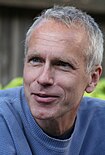 | He is an American Nobel Prize winner of Chemistry in 2012, and is professor in the departments of Molecular and Cellular Physiology at Stanford University School of Medicine. Kobilka attends the Catholic Community at Stanford, Calif.[195] |
| Karl W. Giberson (born 1957) |  | Canadian physicist and evangelical, who has published several books on the relationship between science and religion, such as The Language of Science and Faith: Straight Answers to Genuine Questions and Saving Darwin: How to be a Christian and Believe in Evolution. |
| Rosalind Picard (born 1962) |  | Rosalind Picard is a Professor of Media Arts and Sciences at MIT, director and also the founder of the Affective Computing Research Group at the MIT Media Lab, co-director of the Things That Think Consortium, and chief scientist and co-founder of Affectiva. Picard says that she was raised an atheist, but converted to Christianity as a young adult.[196] |
| Martin Nowak (born 1965) | Evolutionary biologist and mathematician best known for evolutionary dynamics. He teaches at Harvard University, which is pictured in an old drawing.[197] | |
| John Lennox |  | Mathematician, philosopher of science and pastoral adviser. His works include the mathematical The Theory of Infinite Soluble Groups and the religion-oriented God's Undertaker – Has Science buried God? He has also debated religion with Richard Dawkins. He teaches at Oxford, so an old map of it is pictured.[198] |
| Jennifer Wiseman | She is Chief of the Laboratory for Exoplanets and Stellar Astrophysics at NASA Goddard Space Flight Center. An aerial of the Center is shown. In addition she is a co-discoverer of 114P/Wiseman-Skiff. In religion is a Fellow of the American Scientific Affiliation and on June 16, 2010 became the new director for the American Association for the Advancement of Science's Dialogue on Science, Ethics, and Religion.[199] | |
| Ard Louis |  | A reader in Theoretical Physics at the University of Oxford. Prior to his post at Oxford he taught Theoretical Chemistry at Cambridge University where he was also director of studies in Natural Sciences at Hughes Hall. He has written for The BioLogos Forum.[200] |
| Larry Wall (born 1954) |  | An American programmer, Wall is the author of the rnUsenet client and the nearly universally-used patch program. Wall developed the Perl interpreter and language while working for Unisys.[201] He is the co-author of Programming Perl (published by O'Reilly), which is the definitive resource for Perl programmers. Wall frequently refers to his Christian faith when speaking in public about Perl. |
| Justin L. Barrett (born 1971) | 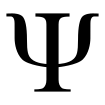 | Director of the Thrive Center for Human Development and Professor of Psychology at Fuller Graduate School of Psychology after being a researcher at Oxford, Barrett is a cognitive scientist specializing in the cognitive science of religion. He has published "Cognitive Science, Religion, and Theology" (Templeton Press, 2011). Barrett has been described by the New York Times as 'an observant Christian who believes in “an all-knowing, all-powerful, perfectly good God who brought the universe into being,” as he wrote in an e-mail message. “I believe that the purpose for people is to love God and love each other.”'[202] |
| Pamela Gay (born ????) |  | An American astronomer, educator and writer, best known for her work in astronomical podcasting. Doctor Gay received her PhD from the University of Texas, Austin, in 2002. |
See also
- American Scientific Affiliation
- Association of Christians in the Mathematical Sciences
- Christians in Science
- Issues in Science and Religion
- List of Roman Catholic scientist-clerics
- List of Catholic scientists
- Lists of Christians
- List of Jesuit scientists
- Quakers in science
- List of Jewish scientists and philosophers
- List of Muslim scientists
- List of atheists (science and technology)
- List of science and religion scholars
- Society of Ordained Scientists
- Veritas Forum
- Victoria Institute
Notes
- ^ He was also called John of Alexandria, hence the picture.
- ^ In 1252 he helped appoint Thomas Aquinas to a Dominican theological chair in Paris to lead the suppression of these dangerous ideas.
- ^ This attempt was, and is, considered unsuccessful by the Catholic Church so his philosophy is still considered erroneous in it.
- ^ Although Jansenism was a movement within Roman Catholicism, it was generally opposed by the Catholic hierarchy and was eventually condemned as heretical.
- ^Carl Wilhelm Scheele discovered oxygen earlier but published his findings after Priestley.
- ^ In the biography by Cambell (p. 170) Maxwell's conversion is described: "He referred to it long afterwards as having given him a new perception of the Love of God. One of his strongest convictions thenceforward was that 'Love abideth, though Knowledge vanish away.'"
- ^ He stated that: "Both Religion and science require a belief in God. For believers, God is in the beginning, and for physicists He is at the end of all considerations… To the former He is the foundation, to the latter, the crown of the edifice of every generalized world view."
- ^ He teaches at Kraków, hence the picture of a Basilica from the city.
References
- ^ The End of the Classical World, (Lecture 12), in Lawrence M. Principe (2002) History of Science: Antiquity to 1700. Teaching Company, Course No. 1200
- ^Cornell University[1] and Stanford University[2]
- ^ David Edward Cartwright (1999). Tides: A Scientific History. Cambridge University Press. ISBN 0-521-62145-3.
- ^ Ott, M. (1911). Blessed Maurus Magnentius Rabanus. In The Catholic Encyclopedia. New York: Robert Appleton Company. http://www.newadvent.org/cathen/12617a.htm
- ^ Holmes, George (1990). The Oxford illustrated history of medieval Europe. Oxford: Oxford University Press. p. 52. ISBN 978-0-19-285435-3.
- ^ Marcus Louis Rautman (2006), Daily Life in the Byzantine Empire (Greenwood Publishing Group, ISBN 0-313-32437-9), 294–95.
- ^ "History of the Pianola". Pianola Institute.
- ^The church in the shadow of the mosque: Christians and Muslims in the world ... by Sidney Harrison Griffith
- ^ James Edward McClellan; Harold Dorn (2006). Science and technology in world history: an introduction. JHU Press. pp. 175–176. ISBN 978-0-8018-8360-6. Retrieved 24 January 2011.
- ^ Buddhue, John Davis. "The Origin of Our Numbers," The Scientific Monthly (Volume 52, Number 3, 1941): 265–267.
- ^ Pages 467–72. Darlington, Oscar G. "Gerbert, the Teacher," The American Historical Review (Volume 52, Number 3, 1947): 456–476.
- ^History of the Christian Church
- ^McTutor
- ^ a b The Science of Creation, (Lecture 20), in Lawrence M. Principe (2002) History of Science: Antiquity to 1700. Teaching Company, Course No. 1200
- ^ (p.36-37) Brian Duignan. Medieval Philosophy - From 500 to 1500 CE. Rosen Educational Publishing, 2010, ISBN 1-61530-143-7
- ^ "William Of Conches." Encyclopædia Britannica. Encyclopædia Britannica Online. Encyclopædia Britannica, 2010. Web. 31 Dec. 2010. <http://www.britannica.com/EBchecked/topic/644253/William-of-Conches>.
- ^ Gertrud Jaron Lewis (2006). "Hildegard von Bingen". In Richard K. Emmerson; Sandra Clayton-Emmerson. Key Figures in Medieval Europe - An Encyclopedia. Routledge. pp. 229–30. ISBN 978-0-415-97385-4. Unknown parameter
|local=ignored (help) - ^ Edward Grant, "Science in the Medieval University", in James M. Kittleson and Pamela J. Transue, ed., Rebirth, Reform and Resilience: Universities in Transition, 1300-1700, Columbus: Ohio State University Press, 1984, p. 68
- ^ A. C. Crombie, Robert Grosseteste and the Origins of Experimental Science 1100–1700, (Oxford: Clarendon Press, 1971)
- ^ Lawrence & Nancy Goldstone (2005). The Friar and the Cipher. Doubleday. ISBN 0-7679-1472-4. & Richard Hofstadter (1996). Academic Freedom in the Age of the College. Transaction books. ISBN 1-56000-860-1.
- ^ Helen S. Lang (1992). Aristotle's Physics and Its Medieval Varieties. State University of New York Press. ISBN 0-7914-1083-8. and Lawrence & Nancy Goldstone (2005). The Friar and the Cipher. Doubleday. ISBN 0-7679-1472-4.
- ^ Lawrence & Nancy Goldstone (2005). The Friar and the Cipher. Doubleday. ISBN 0-7679-1472-4. and Lindberg, D.C. (1995). "Medieval Science and Its Religious Context". Osiris 10 (10): 60–79. doi:10.1086/368743. JSTOR 301913.
- ^Stanford Encyclopedia of philosophy
- ^Catholic Encyclopedia
- ^ Spade, Paul Vincent, "William of Ockham", The Stanford Encyclopedia of Philosophy (Fall 2008 Edition), Edward N. Zalta (ed.), URL = <http://plato.stanford.edu/archives/fall2008/entries/ockham/>.
- ^ Essay "Scientific Revolutions as Changes of Worldview" by Thomas Samuel Kuhn in Can Theories be Refuted?: Essays on the Duhem-Quine Thesis edited by Sandra G. Harding. (D. Reidel Publishing Company, 1976)[3]
- ^Cosmos: An Illustrated History of Astronomy and Cosmology by John North, pg 231
- ^ [books.google.com/books?id=pqr0SDaFxVYC&pg=PA171&lpg=PA171&dq="Nicephorus+Gregoras" Aladdin's Lamp by John Freely]
- ^ Thomas F. Glick, Steven John Livesey, & Faith Wallis, ed. (2005). Medieval Science, Technology, and Medicine: An Encyclopedia. Routledge. ISBN 0-415-96930-1.
- ^ James Edward McClellan; Harold Dorn (2006). Science and technology in world history: an introduction. JHU Press. pp. 191–193. ISBN 978-0-8018-8360-6. See, for instance, this graph
- ^McTutor
- ^ Meyers Konversationslexikon 1888–1889, Jahn, I. Geschichte der Biologie. Spektrum 2000, and Mägdefrau, K. Geschichte der Botanik. Fischer 1992
- ^Catholic Encyclopedia and page 4 from: McMullin, Ernan, ed. (2005). The Church and Galileo. Notre Dame, IN: University of Notre Dame Press. ISBN 0-268-03483-4.
- ^ Page 6 from: McMullin, Ernan, ed. (2005). The Church and Galileo. Notre Dame, IN: University of Notre Dame Press. ISBN 0-268-03483-4. AND pages 346-347 from: Coyne, George V., S.J. (2005). The Church's Most Recent Attempt to Dispel the Galileo Myth. In McMullin (2005, pp.340–59).
- ^Salon review of a biography of Servetus, History of Science article
- ^ Walter William Rouse Ball (1908). A short account of the history of mathematics. Macmillan and Co. p. 216.
- ^ Vivian Shaw Groza and Susanne M. Shelley (1972). Precalculus mathematics. 9780030776700. p. 182. ISBN 978-0-03-077670-0.
- ^University of Florida, Galileo Project at Rice University, and McTutor
- ^Galileo Project
- ^McTutor
- ^Catholic Encyclopedia; The Pope and the Heretic by Michael White and Michael J. Crowe (2006). "Extraterrestrial Life and Christianity". In Eisen and Laderman. Science, Religion, And Society: An Encyclopedia of History, Culture, And Controversy 1. M E Sharpe. p. 299.
- ^McTutor
- ^McTutor
- ^Galileo Project and Adherents.com and Anne-Lee Gilder; Joshua Gilder (14 June 2005). Heavenly Intrigue: Johannes Kepler, Tycho Brahe, and the Murder Behind One of History's Greatest Scientific Discoveries. Random House Digital, Inc. ISBN 978-1-4000-3176-4. Retrieved 3 October 2012.
- ^Catholic Encyclopedia
- ^Uppsala University
- ^MacTutor archive
- ^McTutor
- ^The Galileo Project and Stanford Encyclopedia of Philosophy
- ^Cosmovisions and The Galileo ProjectRice University's Galileo Project
- ^McTutor
- ^A Short Biographical Dictionary of English Literature and MacTutor
- ^McTutor
- ^Australian E-Journal of Theology and Paleontologia Electronica
- ^Galileo Project and University of Hanover's philosophy seminar
- ^ASA and Stanford University[4]
- ^Galileo Project and University of Hanover's philosophy seminar
- ^University of California, Berkeley
- ^McTutor
- ^Gutenberg.org copy of that book
- ^ James E. Force, Richard Henry Popkin, ed. (1990). Essays on the Context, Nature, and Influence of Isaac Newton's Theology. Springer. p. 53. ISBN 9780792305835. "Newton has often been identified as a deist. ...In the 19th century, William Blake seems to have put Newton into the deistic camp. Scholars in the 20th-century have often continued to view Newton as a deist. Gerald R. Cragg views Newton as a kind of proto-deist and, as evidence, points to Newton's belief in a true, original, monotheistic religion first discovered in ancient times by natural reason. This position, in Cragg's view, leads to the elimination of the Christian revelation as neither necessary nor sufficient for human knowledge of God. This agenda is indeed the key point, as Leland describes above, of the deistic program which seeks to "set aside" revelatory religious texts. Cragg writes that, "In effect, Newton ignored the claims of revelation and pointed in a direction which many eighteenth-century thinkers would willingly follow." John Redwood has also recently linked anti-Trinitarian theology with both "Newtonianism" and "deism.""
- ^ Suzanne Gieser. The Innermost Kernel: Depth Psychology and Quantum Physics. Wolfgang Pauli's Dialogue with C.G. Jung. Springer. pp. 181–182. ISBN 9783540208563. "Newton seems to have been closer to the deists in his conception of God and had no time for the doctrine of the Trinity. The deists did not recognize the divine nature of Christ. According to Fierz, Newton's conception of God permeated his entire scientific work: God's universality and eternity express themselves in the dominion of the laws of nature. Time and space are regarded as the 'organs' of God. All is contained and moves in God but without having any effect on God himself. Thus space and time become metaphysical entities, superordinate existences that are not associated with any interaction, activity or observation on man's part."
- ^ Joseph L. McCauley (1997). Classical Mechanics: Transformations, Flows, Integrable and Chaotic Dynamics. Cambridge University Press. p. 3. ISBN 9780521578820. "Newton (1642–1727), as a seventeenth century nonChristian Deist, would have been susceptible to an accusation of heresy by either the Anglican Church or the Puritans."
- ^ Hans S. Plendl, ed. (1982). Philosophical problems of modern physics. Reidel. p. 361. "Newton expressed the same conception of the nature of atoms in his deistic view of the Universe."
- ^ Avery Cardinal Dulles. The Deist Minimum. 2005.
- ^The Maclaurin Institute
- ^The Galileo Project and 1902 Encyclopedia
- ^McTutor
- ^Encyclopædia Britannica Eleventh Edition
- ^Swedenborgian site
- ^Berkeley bio
- ^Mathematics and the Divine By T Koetsier, L Bergmans, Inc NetLibrary
- ^Britannica.com
- ^ Pages 1-7, (Introduction) in: Ronald L. Numbers (ed.) Galileo Goes to Jail, and Other Myths about Science and Religion (Cambridge, MA: Harvard University Press, 2009). Note: the first tree chapters of the book can be found here [5].
- ^Lucasian Chair
- ^Royal Society and Thoemmes
- ^Preface to "Evidences" and 1911 Encyclopedia
- ^ Narins, Brigham, ed. (2001). World of Mathematics 1 (illustrated ed.). Farmington Hills, Michigan: Gale. p. 72. ISBN 9780787650643. Retrieved 14 June 2012.
- ^University of Oxford site
- ^Catholic Encyclopedia and Istanbul Technical University
- ^University of Texas article
- ^ MacHale, Des (1985). George Boole: His Life and Work. Profiles of Genius 3 (illustrated ed.). Dublin: Boole. p. 40. ISBN 978-0-906783-05-4. OCLC 461879478. Retrieved April 28, 2012.
- ^1911 encyclopedia and Amherst College[6]
- ^Stanford philosophy site and Middlesex University article
- ^BBC[7] and Adherents.com
- ^Victorian Web and Virginia Polytechnic Institute and State University[8]
- ^ Scientists of Faith and University of California, Santa Barbara
- ^Royal Meteorological Society
- ^The College of Charleston and Newberry College
- ^Royal Society's obituaries, pages 227–235
- ^ James Clerk Maxwell and religion, American Journal of Physics, 54 (4), April 1986, p.314
- ^ James Clerk Maxwell and religion, American Journal of Physics, 54 (4), April 1986, p. 312–317 ; James Clerk Maxwell and the Christian Proposition by Ian Hutchinson
- ^ Burgess, Walter H., ed. (2007) [1923]. Transactions of the Unitarian Historical Society 3. University of Michigan: Lindsey. p. 418. Retrieved June 14, 2012.
- ^"Guyot's Geoscience and Geohistory", Princeton articleCreation, or the Biblical Cosmogony in the Light of Modern Science
- ^Catholic Encyclopedia
- ^University of Houston hosted article.[9]
- ^Gutenberg text of Darwiniana and ASA
- ^McTutor
- ^Dictionary of Australian biography
- ^ Cardwell, Donald S.L. (1990). James Joule: A Biography ([Repr.]. ed.). Manchester: Manchester University Press. pp. 266, 271. ISBN 0719034795.
- ^ Koertge, Noretta (2007). p. 340. Unknown parameter
|tite=ignored (help); Missing or empty|title=(help) - ^"Science and the Bible" at Google Books and Engines of Our Ingenuity
- ^Biography on Louis Pasteur
- ^ *
 "St. George Jackson Mivart, Ph.D., M.D., F.R.S., V.P.Z.S., F.Z.S.". Catholic Encyclopedia. New York: Robert Appleton Company. 1913. Also the end of the Catholic Encyclopedia article on Hell mentions him.[10]
"St. George Jackson Mivart, Ph.D., M.D., F.R.S., V.P.Z.S., F.Z.S.". Catholic Encyclopedia. New York: Robert Appleton Company. 1913. Also the end of the Catholic Encyclopedia article on Hell mentions him.[10] - ^The Vicentians
- ^Gifford Lectures site.[11][12]
- ^George Salmon: from mathematics to theology
- ^University of Durham
- ^Institute of Physics[13] and his own article.
- ^McTutor and Scientist and Catholic: Pierre Duhem by Stanley Jaki[14]
- ^IUPUI[15]
- ^ Miss Leavitt's Stars by George JohnsonISBN 0-393-05128-5
- ^[16]
- ^McTutor
- ^On pg 267 he refers to "we Christians."
- ^ Second paragraph of Page 26 in a paper from Middlesex UniversityMiddlesex University article
- ^The Guardian and The Cambridge guide to women's writing in English by Lorna Sage, Germaine Greer, Elaine Showalter; pg 271
- ^[17]
- ^Man of science-and of God from The New American (January 2004) via TheFreeLibrary.com
- ^[18]
- ^IEEE biographyUniversity College London
- ^Adherents,com and Religion and Natural Science (Lecture Given 1937) Scientific Autobiography and Other Papers, trans. F. Gaynor (New York, 1949), pp. 184
- ^Civilized Life in the Universe By George Basalla, pg 128 and Incarnation and Resurrection By Paul D. Molnar, pg 95
- ^Nobel Biography
- ^American Institute of Chemical Engineers and Worldcat
- ^McTutor
- ^American Physical Society[19] and Time (magazine)[20]
- ^Gould on God Can religion and science be happily reconciled?
- ^Catholic Education Resource Center
- ^ Hahn, Otto (1970). My Life: the Autobiography of a Scientist. Herder and Herder. p. 28. Retrieved June 14, 2012.
- ^Western Kentucky University and ASA's book reviews section
- ^McTutor
- ^[21]
- ^ Dobzhansky,Theodosius (March 1973). "Nothing in Biology Makes Sense Except in the Light of Evolution". people.delphiforums.com. Retrieved 2012-05-05.
- ^http://www.newscientist.com/channel/life/evolution/mg14920155.100
- ^ Stewart, Ian (2008). Why Beauty Is Truth: A History of Symmetry. Basic. p. 206. ISBN 9780465082377. Retrieved June 14, 2006.
- ^The religion of Werner Heisenberg, physicist. Adherents.com. Retrieved on 2012-02-01.
- ^Polyaniana
- ^ Tucker McElroy (2005). A to Z of Mathematicians. Infobase Publishing. p. 118. ISBN 9780816053384. "Gödel had a happy childhood, and was called “Mr. Why” by his family, due to his numerous questions. He was baptized as a Lutheran, and re-mained a theist (a believer in a personal God) throughout his life."
- ^ Wang 1996, pp. 104–105.
- ^National Academy of Sciences[22] and Mormon Scientist: The Life and Faith of Henry Eyring by Henry J. Eyring
- ^ Provice, William B. (1989). "13. The Madison Years". Sewall Wright and Evolutionary Biology. Science and Its Conceptual Foundations (reprint, illustrated ed.). Chicago: University of Chicago. pp. 460, 497. ISBN 978-0-226-68473-4. OCLC 24604423. Retrieved April 28, 2012.
- ^ Pam Bonee, William G. Pollard, Tennessee Encyclopedia of History and Culture.
- ^ Eliel, Ernest L., Frederick Dominic Rossini, Biographical Memoirs, National Academy of Sciences.
- ^The Palm Beach Post
- ^University of Maryland and ASA
- ^MacTutor bio
- ^adherents.com
- ^Brazilian Academy of Sciences
- ^Obituary and CiS
- ^Obituary at Hope College and Tuskegee University
- ^Obituary at the Universidad de Navarra
- ^Society of Ordained Scientists' website
- ^ASA
- ^Seton Hall University site.[23]
- ^The religion essay, astronomy article, Bruce Medalist page, and Science and the spiritual quest: new essays by leading scientists by W. Mark Richardson, pg 52
- ^[24]
- ^University of California, Berkeley[25] and Templeton Prize's site.[26]
- ^Templeton Prize site
- ^[27]
- ^[28]
- ^Official Biography of Zichichi at the Ettore Majorana FoundationInternational Seminar on Nuclear War and Planetary Emergencies: 25th session ... by Antonino Zichichi, Richard C. Ragaini, Ettore M, pg 4
- ^His own website
- ^ Space.com [29] and Cambridge Christians in Science.[30]
- ^Christians in Science
- ^ Russell Stannard, Science & Wonders, p74
- ^[31]
- ^iv press and Christians in Science
- ^[32]
- ^Templeton Foundation, Journal of Mathematical Physics, and ISSR
- ^[33]
- ^CiS interview
- ^His website
- ^[34]
- ^ [Cambridge University. April 17, 2011. Retrieved 2011-04-23. "The new study is based on earlier research which Professor Humphreys carried out with the Oxford astrophysicist, Graeme Waddington, in 1983. This identified the date of Jesus’ crucifixion as the morning of Friday, April 3rd, AD 33 – which has since been widely accepted by other scholars as well. For Professor Humphreys, who only studies the Bible when not pursuing his day-job as a materials scientist, this presented an opportunity to deal with the equally difficult issue of when (and how) Jesus’ Last Supper really took place."]
- ^[35]
- ^[36]
- ^Faraday Institute and Eric Priest's website
- ^Stephen Hawking, the Big Bang, and God, by H. F. Schaefer and Foundational Questions Institute
- ^University of Georgia Athens
- ^Interview with him at Prehistoric planet and a Spiritual site linked to him
- ^[37]
- ^[38]
- ^[39]
- ^[40]
- ^[41]
- ^St. Petersburg Times[42]
- ^ASA and Genome.gov
- ^ Karen Gaudette (May 16, 2007). "The mother of cheesemaking has art down to a science". The Seattle Times. Retrieved 2009-01-18.
- ^Gifford Lectures, Boyle Lecture, Boston University.
- ^The New York Times, March 16, 2006 and Templeton Prize bio
- ^Faraday Institute Biography
- ^ Susskind, Leonard (2008). The Black Hole War: My battle with Stephen Hawking to make the world safe for quantum mechanics. Little, Brown. p. 253. ISBN 0-316-01640-3.
- ^University of Delaware,University of Notre Dame Press, and Interview at Ignatius Insight
- ^[43]
- ^ [Petricevic, Mirko (2007-11-03). "A scientist who embraces God". The Record (Kitchener, Ontario: Metroland Media Group Ltd.). Retrieved 2008-05-06.]
- ^ Barlow, Rich (27 September 2008). "Mathematics and faith explain altruism". The Boston Globe.
- ^Mathematics Genealogy Project and The Wall Street Journal
- ^AAAS
- ^[44]
- ^Larry Wall.
- ^[45]
External links
- Christianity And The Scientist by Ian G. Barbour
- Cambridge Christians in Science (CiS) group
- Christians in Science website
- Ian Ramsey Centre, Oxford
- The Society of Ordained Scientists-Mostly Church of England
- "Science in Christian Perspective" The (ASA)
- Canadian Scientific and Christian Affiliation (CSCA)
- The International Society for Science & Religion's founding members.(Of various faiths including Christianity)
- Association of Christians in the Mathematical Sciences
- Secular Humanism.org article on Science and Religion
- The New Christian Bible Study A bible study site with theological underpinnings based on Emanuel Swedenborg's religious works from the 1700's.
